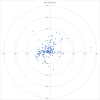Hi,
I am trying to create a scatter graph that shows hole deviation between several drill hole collar locations.
I have the x and y axes values of the design holes as well as the actual drilled holes and I want to compare the deviation between the design drill holes position and the actual drill hole positions.
Appreciate any suggestions or help with my query.

I am trying to create a scatter graph that shows hole deviation between several drill hole collar locations.
I have the x and y axes values of the design holes as well as the actual drilled holes and I want to compare the deviation between the design drill holes position and the actual drill hole positions.
Appreciate any suggestions or help with my query.





